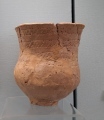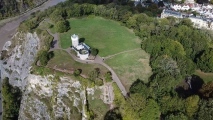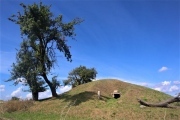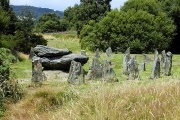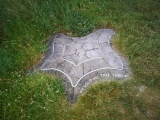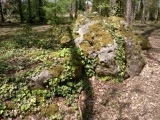Andy Burnham's Blog, page 125
October 29, 2022
Steinsvettaberget Hillfort
See lower down our page for a fun 3D reconstruction video of how this hillfort might have looked. Located on three north-east to south-west oriented natural plateaus with different heights with the steepest sides to the south-east and north-west. There is a footpath leading from a local road and a car park with an information poster at the river up to the hillfort but the walk is long and goes up several steep hills. It is probably the longest walk I have had to get up to any hillfort!
Published on October 29, 2022 07:20
October 28, 2022
Museum des Kreises Ploen
Museum in Plön, Schleswig-Holstein, Hamburg. Photo: A funnel beaker, decorated with indentations, found in a long barrow near Wetterade, Helmstorf. Also on display are a famous cup marked stones - the Schalenstein of Klein Meinsdorf and Nessendorf (on our page) and much else besides.
Published on October 28, 2022 06:11
October 27, 2022
Clifton Down Camp
An Iron Age hillfort on the eastern side of the sheer Avon Gorge, just to the north of the Clifton Suspension Bridge and now a part of the splendid Clifton Downs parkland. Approximately circular, double ditches and banks run around in a clockwise direction from the northwest to the southeast, with the earthen ramparts now covered in dense tree growth. The southwestern side needs no defending, being on top of a 200 feet sheer cliff. The central area of the fort is grassed over and a splendid place for a picnic, in the middle of which is the Clifton Observatory, with its Camera Obscura, and the tunnel down into the cave which opens out into the sheer rock face of the Avon Gorge partway down to the river.
Published on October 27, 2022 08:21
October 26, 2022
Langenbek Grabhuegel mit Steinkreis
A rather lovely round barrow with circle of kerb stones visible. In a park area in Langenbek, near Harburg, Hamburg.
Published on October 26, 2022 03:31
October 25, 2022
Neble Jordehøj Jættestue
Jordehøj passage grave is located just north of the village of Neble on the island of Møn. Its status as a surviving major prehistoric site can be attributed to the efforts of a local amateur archaeologist Gustav Hage who in 1830 undertook a survey of the site and raised awareness of its importance. An excavation was undertaken in 1836 after learning that another important local site Sognehøj was already being demolished, the large stones finding a ready market for construction work. Finds at Jordehøj included 3 skulls which fortunately Hage took to his home in nearby Stege as the residual finds were subject of a theft from the site, such things finding a ready market from collectors at that time.
Published on October 25, 2022 08:37
October 24, 2022
Carreg Siglio
The Rocking Stone on Coedpenmaen Common (a natural stone) was a focal point for public meetings in Pontypridd, ranging from industrial, Chartist and Co-operative rallies to Druidic ceremonies. The ancient stone was supplemented with a Gorsedd circle by Myfyr Morganwg in 1849. The stone is perhaps best known, however, for its links to one of the areas most infamous residents. Dr William Price would regularly address crowds here. It was also here in 1881 that he married Gwenllian Llewellyn.
Published on October 24, 2022 02:41
October 23, 2022
Columbos Nuraghe (Sedilo)
Nuraghe in Sardinia (Sardegna). Nuraghe Columbos is a single-towered structure located north of Sedilo, few hundred meters west of the road to Noragugume. The tower survived in relatively good condition, with mostly preserved tholos chamber. Inside the chamber there are three niches.
Published on October 23, 2022 05:54
October 22, 2022
Stonehenge Car Park Postholes
In the former visitors' car park at Stonehenge there were three large round white 'blobs' on the tarmac often overlooked by motorists and visitors to Stonehenge. These marked the places where Mesolithic posts one stood in around 8,000 BC. A fourth feature was also found which did not contain evidence for a timber post, this was interpreted as a tree-throw hole. The car park has now moved and the location of each post hole is marked with a kind of little podium, or "sensitively designed low level marker". The one for the possible tree throw here looks rather like a buried giant tortoise, which will not, we hope, confuse any slightly short sighted zooarchaeologists from the future.
Published on October 22, 2022 06:10
Dolmen de Baneuil
Found by LaDragonne - ten years after Martyn/TheCaptain created the page for it. The remains of a dolmen on private property, in the village of Baneuil. A few slabs remain on top of a small mound. A local guide book relays the tale that an English General is buried underneath it. (?)
Published on October 22, 2022 04:50
October 20, 2022
Hackness Church
St Peters Church Hackness began life in 680AD when St Hilda of Whitby founded a nunnery here. The nunnery was mentioned by the Venerable Bede in the 8th century. The weathered Anglo-Saxon cross is almost 1.8m (6 ft) tall and also dates to around the 8th century. The cross bears an inscription in Latin addressed to St AEthelburh as well as inscriptions in runic and ogham, and carvings of Celtic patterns, and gryphons. Legend says that the bells of Hackness tolled when St Hilda died in 681AD. The nunnery may have succumbed in 867 AD when the Danes ransacked the coast.
Published on October 20, 2022 10:16


